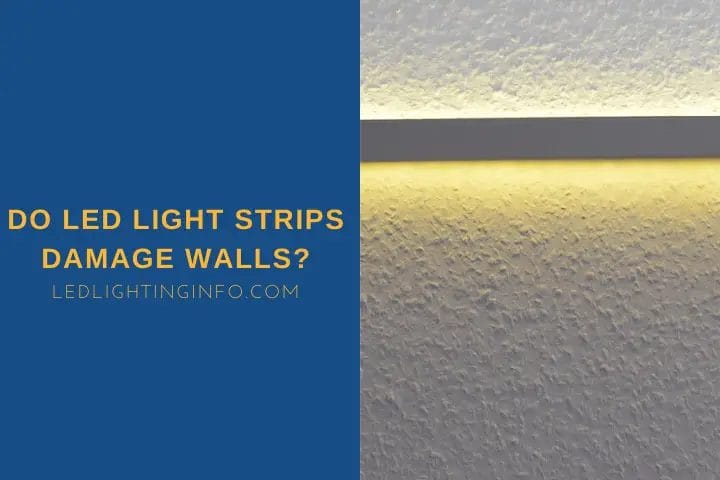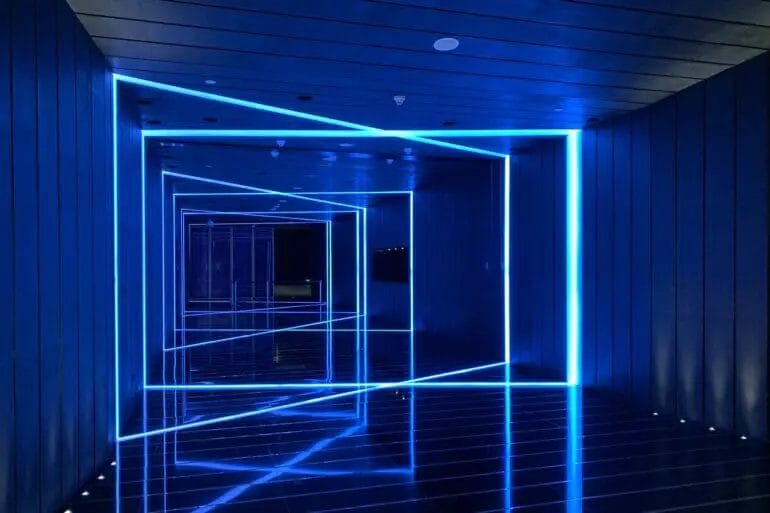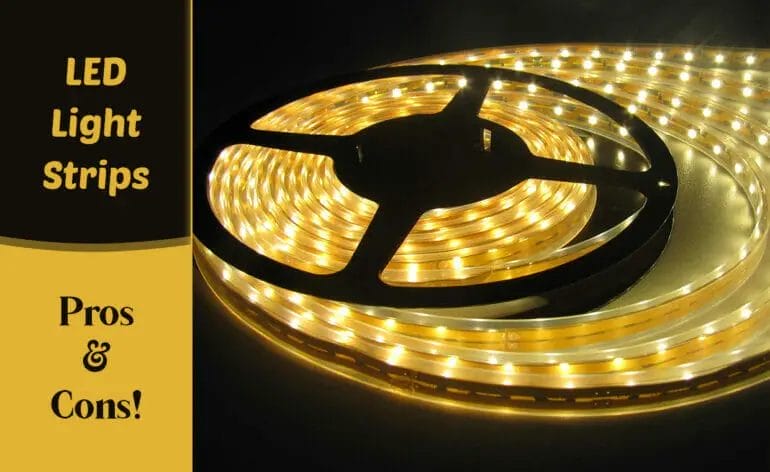LED lights are known for their energy efficiency and longevity, but many people wonder if they can cause any damage to the walls. The good news is that LED lights do not pull paint off walls. Unlike traditional incandescent or halogen lights, LED lights emit very little heat, which means they do not heat up the walls enough to cause the paint to peel or bubble. So, you can enjoy the benefits of LED lighting without worrying about any harm to your walls.

Choosing the Right LED Lights: A Guide to LED Light Types that Won’t Pull Paint off Walls
When it comes to lighting up our homes or office spaces, LED lights have become the top choice for many people. They are energy-efficient, long-lasting, and offer a wide range of lighting options. However, not all LED lights are created equal, and some can be more damaging to your walls than others. In this guide, we will discuss the different types of LED lights and help you choose the right ones that won’t pull paint off your walls.
1. LED Bulbs
LED bulbs are the most common type of LED lights available in the market. They come in various shapes and sizes, making them suitable for different lighting fixtures. When it comes to wall paint, it is essential to choose LED bulbs that emit minimal heat. Heat can cause the paint to expand and contract, leading to cracks or peeling. Look for LED bulbs that are labeled as “cool white” or “warm white” as they emit less heat compared to other color temperatures.
2. LED Light Strips
LED light strips are a popular choice for adding ambient or accent lighting to a room. These flexible strips can be easily installed along the edges of walls or under cabinets. When choosing LED light strips, opt for those with a low wattage and heat output. Make sure to also check if the adhesive backing is safe for your wall surface to avoid any damage when removing the strips in the future.
3. LED Recessed Lights
LED recessed lights are a sleek and modern lighting option that can be installed directly into the ceiling or walls. These lights provide a clean, seamless look and are often used for general lighting purposes. To prevent any damage to your walls, choose LED recessed lights that are specifically designed for insulation contact (IC) rated ceilings. These lights are built to withstand any heat buildup and are safe to install without the risk of damaging your walls.
4. LED Track Lights
LED track lights are versatile and can be adjusted to illuminate specific areas or objects in a room. They are commonly used in galleries, showrooms, or retail spaces. When selecting LED track lights, consider those with adjustable heads that can be pointed away from the walls to minimize any heat exposure. Additionally, choose lights with a higher color rendering index (CRI) to ensure accurate color representation without causing any damage to your walls.
5. LED Wall Sconces
LED wall sconces are decorative lighting fixtures that can add elegance and style to any space. These lights are typically mounted on the walls and can provide both ambient and task lighting. When choosing LED wall sconces, opt for fixtures that have built-in heat sinks to dissipate any excess heat. This will ensure that the lights do not generate too much heat that could potentially damage your walls.
In summary, when choosing LED lights for your home or office, it is crucial to consider the type of light and its heat output. Opt for LED bulbs, light strips, recessed lights, track lights, and wall sconces that emit minimal heat to prevent any damage to your walls. By selecting the right LED light types, you can enjoy the benefits of energy-efficient lighting without worrying about paint peeling or cracking.

Tips for Proper Installation: Ensuring LED Lights Don’t Damage Your Wall Paint
LED lights are a popular choice for homeowners looking to enhance the ambiance of their living spaces. These energy-efficient lighting options offer a range of benefits, including long lifespan, low energy consumption, and customizable lighting effects. However, improper installation can lead to potential damage to your wall paint. In this section, we will discuss some essential tips to ensure that your LED lights are installed correctly without causing any harm to your walls.
1. Choose the Right Type of LED Lights
Before starting the installation process, it is crucial to select the right type of LED lights that are suitable for your wall. LED lights come in various forms, including tape lights, panel lights, and recessed lights. Tape lights are flexible and easy to install, making them a popular choice. However, if you opt for tape lights, make sure they are installed on a smooth surface to avoid damaging the wall paint.
2. Prepare the Wall Surface
Prior to installing LED lights, it is essential to prepare the wall surface adequately. Start by cleaning the wall to remove any dust, dirt, or grease. This will ensure better adhesion of the LED lights and prevent any damage to the paint. Additionally, if you plan on using adhesive to secure the lights, make sure the wall is free from any imperfections or loose paint. You can use sandpaper or a putty knife to smooth out any rough patches.
3. Use Proper Mounting Techniques
When installing LED lights, it is essential to use proper mounting techniques to prevent damage to the wall paint. Avoid using nails or screws directly on the wall, as this can leave unsightly marks or even cause cracks. Instead, opt for mounting brackets or clips that are specifically designed for LED lights. These accessories provide a secure and damage-free installation.
4. Test Before Permanent Installation
Before permanently installing the LED lights, it is advisable to test them for functionality and placement. This can be done by temporarily attaching the lights using removable adhesive or tape. By testing the lights beforehand, you can ensure that they are positioned correctly and provide the desired lighting effect. This step helps prevent any unnecessary adjustments or repositioning that can potentially damage the paint.
5. Seek Professional Help if Needed
If you are unsure about installing LED lights or if you have complex lighting requirements, it is always best to seek professional help. Electricians or lighting specialists have the expertise and knowledge to install LED lights safely and accurately. They can ensure that the lights are installed without causing any damage to your wall paint.
In summary, proper installation of LED lights is crucial to prevent any damage to your wall paint. By following these tips, you can enjoy the benefits of LED lighting while keeping your walls in pristine condition. Remember to choose the right type of LED lights, prepare the wall surface, use proper mounting techniques, test before permanent installation, and seek professional help if needed. With these precautions in place, you can illuminate your space with LED lights confidently.

Repairing Damaged Paint: How to Fix Paint Damage Caused by LED Lights
If you have noticed paint damage on your vehicle or any other surface caused by LED lights, don’t fret! There are effective ways to repair and restore the damaged paint. LED lights emit a high-intensity light that can cause discoloration and fading of paint over time. In this section, we will explore the steps you can take to fix the paint damage caused by LED lights.
1. Assess the Extent of the Damage
The first step in repairing damaged paint caused by LED lights is to assess the extent of the damage. Inspect the affected area closely to determine how deep the damage goes. If the damage is only superficial, you may be able to fix it using simple techniques. However, if the paint has been completely stripped or if there are deep scratches, you may need professional assistance.
2. Clean the Damaged Area
Before attempting any repairs, it’s important to thoroughly clean the damaged area. Use a mild soap or automotive cleaner and a clean cloth to remove any dirt, debris, or contaminants from the surface. This will ensure that the repair products adhere properly to the paint.
3. Sand the Damaged Area
If the paint damage is shallow, you can use sandpaper to smooth out the damaged area. Start with a fine-grit sandpaper and gradually move to a coarser grit if necessary. Gently sand the damaged area in a circular motion until the surface feels smooth to the touch. Be careful not to sand too aggressively, as this can damage the surrounding paint.
4. Apply Primer
Once the damaged area is smooth, it’s time to apply primer. Primer helps to create a smooth surface for the paint and improves adhesion. Choose a primer that is specifically designed for automotive use and follow the manufacturer’s instructions for application. Use a paintbrush or a spray can to apply a thin and even coat of primer to the repaired area. Allow the primer to dry completely before proceeding to the next step.
5. Apply Touch-Up Paint
After the primer has dried, it’s time to apply touch-up paint that matches the color of your vehicle or surface. You can find touch-up paint at your local automotive store or from the manufacturer of your vehicle. Use a small brush or a touch-up pen to carefully apply the paint to the damaged area. Apply thin layers and allow each layer to dry before applying the next. Repeat this process until the repaired area is completely covered.
6. Polish and Wax
Once the touch-up paint has dried, it’s important to polish and wax the repaired area to blend it with the surrounding paint. Use a fine polishing compound and a clean cloth to gently buff the repaired area. This will help to remove any imperfections and give the paint a smooth and glossy finish. After polishing, apply a coat of wax to protect the repaired area and enhance the overall appearance.
7. Maintain and Protect
After repairing the damaged paint caused by LED lights, it’s essential to maintain and protect the surface to prevent future damage. Regularly wash and wax your vehicle or surface to keep the paint in good condition. Additionally, consider using protective films or covers to shield the surface from direct exposure to LED lights or other potential sources of damage.
In summary, repairing paint damage caused by LED lights is a manageable task with the right approach. Assess the extent of the damage, clean the area, sand if necessary, apply primer and touch-up paint, polish and wax, and maintain the restored area. By following these steps, you can effectively fix the paint damage and restore the appearance of your vehicle or any other surface.
Alternative Lighting Options: Exploring LED Alternatives to Prevent Paint Damage
When it comes to lighting options, we often think of traditional incandescent or fluorescent bulbs. However, these lighting sources can emit UV radiation that can cause damage to delicate surfaces, such as painted artwork or furniture. In recent years, LED lighting has emerged as a popular alternative that not only provides energy efficiency but also minimizes the risk of paint damage.
1. Understanding the Impact of Traditional Lighting
Traditional lighting sources, such as incandescent or fluorescent bulbs, emit UV radiation as a byproduct of their operation. This UV radiation can interact with organic compounds found in paint pigments, causing them to deteriorate over time. This can result in discoloration, fading, or even complete degradation of the paint.
Furthermore, heat generated by traditional lighting options can also contribute to paint damage. Excessive heat can cause paint to crack, peel, or blister, leading to unsightly and irreversible damage.
2. The Benefits of LED Lighting
LED lighting offers several advantages over traditional options when it comes to preserving paint quality. Firstly, LED bulbs do not emit UV radiation, making them safe for use around delicate surfaces. This eliminates the risk of UV-induced paint damage, ensuring that your painted artwork or furniture remains vibrant and intact.
Secondly, LED bulbs produce significantly less heat compared to incandescent or fluorescent bulbs. This reduced heat output minimizes the risk of heat-related paint damage, providing additional protection to your valuable items. Furthermore, LED lighting is highly efficient, consuming less energy and reducing overall electricity costs.
3. Choosing the Right LED Lighting
When selecting LED lighting for your space, there are a few factors to consider to ensure optimal paint preservation:
- Color Temperature: Choose LED bulbs with a color temperature that complements the paint hue. Warmer color temperatures (2700K-3500K) work well with warm-toned paints, while cooler temperatures (3500K-5000K) suit cooler-toned paints.
- Dimming Capability: If you require adjustable lighting levels, opt for LED bulbs with dimming capabilities. This allows you to customize the lighting intensity based on your specific needs.
- CRI (Color Rendering Index): Look for LED bulbs with a high CRI to accurately showcase the colors of your painted surfaces. A CRI of 90 or above is recommended for optimal color representation.
4. Additional Tips to Protect Painted Surfaces
While LED lighting can significantly minimize the risk of paint damage, there are a few additional steps you can take to ensure the longevity of your painted surfaces:
- Regular Cleaning: Dust and dirt can accumulate on painted surfaces, leading to potential damage. Regularly clean your painted items using a soft, dry cloth to remove any debris.
- UV-Protective Coatings: Apply a UV-protective coating to painted surfaces, especially those exposed to direct sunlight. This additional layer of protection can further safeguard against UV-induced fading or discoloration.
- Proper Storage: When storing valuable painted items, ensure they are kept in a cool, dry environment away from direct sunlight or excessive moisture. This helps to prevent paint damage caused by environmental factors.
5. Conclusion
LED lighting offers a reliable and efficient alternative to traditional lighting options when it comes to preventing paint damage. By choosing LED bulbs that are specifically designed to minimize UV radiation and heat output, you can preserve the quality and longevity of your painted artwork or furniture. Implementing additional protective measures, such as regular cleaning and UV-protective coatings, can further enhance the durability of painted surfaces. Embracing LED lighting not only benefits your paint but also contributes to energy conservation and cost savings.
FAQs
Do LED lights pull paint off walls?
No, LED lights do not pull paint off walls. LED lights generate very little heat compared to traditional incandescent bulbs, so they don’t create enough heat to cause paint damage. You can safely use LED lights in your home without worrying about them damaging the paint on your walls.
Conclusion
In conclusion, LED lights do not pull paint off walls. LED lights are known for their energy efficiency, longevity, and low heat emission. Unlike traditional incandescent or halogen lights, LED lights do not generate excessive heat that can cause paint to peel or bubble. LED lights are safe to use on any type of wall surface, including painted walls. They provide a bright and uniform light distribution, enhancing the overall ambiance of a space without causing any damage to the paint. So, you can confidently enjoy the benefits of LED lighting without worrying about any adverse effects on your walls.
